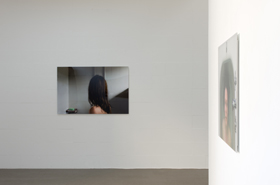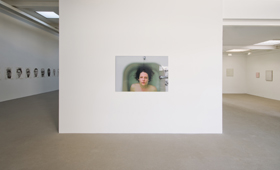Exhibition information
Aino Kannisto
Faces
The Finnish photographer Aino Kannisto is being featured in her fourth solo show at Galerie m Bochum. In her latest photographs, which were for the most part taken in her home country, Kannisto has developed some new characters. She maintains here the subtle melancholy that is the signature mood in much of her work, and yet presents the viewer with further enigmas.
If we share Roland Barthes’ view of the essence of photography, we would assume that a photograph should depict a past event, or, in the words of the French philosopher in his Camera Lucida: “that-has-been.” But is what we see in Aino Kannisto’s photographs something that has been? Can we ever know what has been when the photo was taken? Certainly, in the picture Untitled (Green Soap Bar), there was a bar of green soap in the shower stall in which a woman with long brown hair stood with her back to the camera. Surely, the woman in Untitled (Rushes) had been swimming for some time in the now motionless, deep blue water of the pond in which she can be seen crouching amid the rushes in the golden twilight. All of these references to the reality at the time these photos were taken can be justified; after all, the photographic medium still carries a modicum of credibility even today. And yet, Aino Kannisto’s pictures display neither the truth of the moment nor the unpredictability of coincidence that Roland Barthes attributes to photography: Kannisto does not allow anything to appear in her photographs by chance. No beam of light is unintentional, no angle arbitrary, no gesture unplanned – no matter how subtle.
Each of Kannisto’s photographs is arranged like a theater piece, and the photographer herself is always the protagonist in scenes that open up a vast realm of possible interpretations due to the absolute ambiguity of the events and narratives pictured. It is almost impossible to resist the urge to fill in the gaps and imagine what came before and after. At the same time, the situations Kannisto creates are so vague that we cannot even be sure if the woman in the bathtub is submerging herself in the water or emerging from it. The artist performs a balancing act between fiction and reality, narration and suggestion, familiarity and alienation in precisely constructed compositions that sometimes verge on the abstract and coalesce to form images imbued with a haunting atmosphere.
The Finnish photographer Aino Kannisto is being featured in her fourth solo show at Galerie m Bochum. In her latest photographs, which were for the most part taken in her home country, Kannisto has developed some new characters. She maintains here the subtle melancholy that is the signature mood in much of her work, and yet presents the viewer with further enigmas.
If we share Roland Barthes’ view of the essence of photography, we would assume that a photograph should depict a past event, or, in the words of the French philosopher in his Camera Lucida: “that-has-been.” But is what we see in Aino Kannisto’s photographs something that has been? Can we ever know what has been when the photo was taken? Certainly, in the picture Untitled (Green Soap Bar), there was a bar of green soap in the shower stall in which a woman with long brown hair stood with her back to the camera. Surely, the woman in Untitled (Rushes) had been swimming for some time in the now motionless, deep blue water of the pond in which she can be seen crouching amid the rushes in the golden twilight. All of these references to the reality at the time these photos were taken can be justified; after all, the photographic medium still carries a modicum of credibility even today. And yet, Aino Kannisto’s pictures display neither the truth of the moment nor the unpredictability of coincidence that Roland Barthes attributes to photography: Kannisto does not allow anything to appear in her photographs by chance. No beam of light is unintentional, no angle arbitrary, no gesture unplanned – no matter how subtle.
Each of Kannisto’s photographs is arranged like a theater piece, and the photographer herself is always the protagonist in scenes that open up a vast realm of possible interpretations due to the absolute ambiguity of the events and narratives pictured. It is almost impossible to resist the urge to fill in the gaps and imagine what came before and after. At the same time, the situations Kannisto creates are so vague that we cannot even be sure if the woman in the bathtub is submerging herself in the water or emerging from it. The artist performs a balancing act between fiction and reality, narration and suggestion, familiarity and alienation in precisely constructed compositions that sometimes verge on the abstract and coalesce to form images imbued with a haunting atmosphere.


